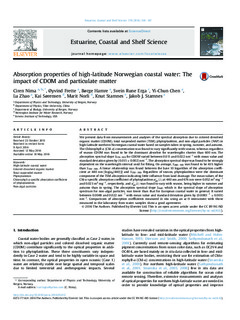| dc.contributor.author | Cirennima, X | |
| dc.contributor.author | Hamre, Børge | |
| dc.contributor.author | Sørensen, Kai | |
| dc.contributor.author | Zhao, Lu | |
| dc.contributor.author | Stamnes, Knut | |
| dc.contributor.author | Erga, Svein Rune | |
| dc.contributor.author | Norli, Marit | |
| dc.contributor.author | Stamnes, Jakob J. | |
| dc.contributor.author | Chen, Yi-Chun | |
| dc.contributor.author | Frette, Øyvind | |
| dc.date.accessioned | 2018-03-20T12:44:16Z | |
| dc.date.available | 2018-03-20T12:44:16Z | |
| dc.date.created | 2016-10-18T15:34:08Z | |
| dc.date.issued | 2016 | |
| dc.identifier.citation | Estuarine, Coastal and Shelf Science. 2016, 178, 158-167. | nb_NO |
| dc.identifier.issn | 0272-7714 | |
| dc.identifier.uri | http://hdl.handle.net/11250/2491270 | |
| dc.description.abstract | We present data from measurements and analyses of the spectral absorption due to colored dissolved organic matter (CDOM), total suspended matter (TSM), phytoplankton, and non-algal particles (NAP) in high-latitude northern Norwegian coastal water based on samples taken in spring, summer, and autumn. The Chlorophyll-a (Chl-a) concentration was found to vary significantly with season, whereas regardless of season CDOM was found to be the dominant absorber for wavelengths shorter than 600 nm. The absorption spectral slope S350 500 for CDOM varied between 0.011 and 0.022 nm 1 with mean value and standard deviation given by (0.015 ± 0.002) nm 1. The absorption spectral slope was found to be strongly dependent on the wavelength interval used for fitting. On average, S280 500 was found to be 43% higher than S350 500. A linear relationship was found between the base 10 logarithm of the absorption coefficient at 440 nm [log(ag(440))] and S350 500. Regardless of season, phytoplankton were the dominant component of the TSM absorption indicating little influence from land drainage. The mean values of the Chl-a specific absorption coefficient of phytoplankton a ph ðlÞ at 440 nm and 676 nm were 0.052 m2 mg 1 and 0.023 m2 mg 1, respectively, and a ph ðlÞ was found to vary with season, being higher in summer and autumn than in spring. The absorption spectral slope SNAP, which is the spectral slope of absorption spectrum for non-algal particles, was lower than that for European coastal water in general. It varied between 0.0048 and 0.022 nm 1 with mean value and standard deviation given by (0.0083 1 ± 0.003) nm 1. Comparisons of absorption coefficients measured in situ using an ac-9 instrument with those measured in the laboratory from water samples show a good agreement. | nb_NO |
| dc.language.iso | eng | nb_NO |
| dc.publisher | Elsevier | nb_NO |
| dc.rights | Attribution-NonCommercial-NoDerivatives 4.0 Internasjonal | * |
| dc.rights.uri | http://creativecommons.org/licenses/by-nc-nd/4.0/deed.no | * |
| dc.title | Absorption properties of high-latitude Norwegian coastal water: The impact of CDOM and particulate matter | nb_NO |
| dc.type | Journal article | nb_NO |
| dc.type | Peer reviewed | nb_NO |
| dc.description.version | publishedVersion | nb_NO |
| dc.source.pagenumber | 158-167 | nb_NO |
| dc.source.volume | 178 | nb_NO |
| dc.source.journal | Estuarine, Coastal and Shelf Science | nb_NO |
| dc.identifier.doi | 10.1016/j.ecss.2016.05.012 | |
| dc.identifier.cristin | 1392702 | |
| dc.relation.project | Norges forskningsråd: 212019 | nb_NO |
| cristin.unitcode | 7464,20,14,0 | |
| cristin.unitname | Marin biogeokjemi og oseanografi | |
| cristin.ispublished | true | |
| cristin.fulltext | original | |
| cristin.qualitycode | 1 | |

